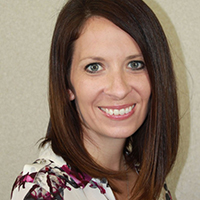Advancing our commitment to antiracism: Insights from Blue Cross MN’s new racial and health equity VP
June 8, 2021In 2020, Blue Cross joined local organizations, municipal and county governments and the Minnesota House of Representatives in declaring that racism is a public health crisis. In the time since that declaration, Blue Cross has continued its ongoing commitment to partner with communities in addressing the root causes of racial and health inequities. It has also taken action internally, by assessing the existing systems and structures within the organization that have historically contributed to inequities.
 Blue Cross’ journey toward becoming an antiracist organization is ongoing, and is now being led by Bukata Hayes, who recently joined the organization as Blue Cross’ vice president of racial and health equity.
Blue Cross’ journey toward becoming an antiracist organization is ongoing, and is now being led by Bukata Hayes, who recently joined the organization as Blue Cross’ vice president of racial and health equity.
We had a chance to talk with Bukata about his new role, his history as a community advocate, and his priorities for this critical work moving forward.
As you step in to lead Blue Cross’ racial and health equity efforts, what will be some critical components to the work?
As I’ve settled into this new position, I’ve been able to have some great conversations throughout the organization about how to partner and work across different parts of the company to ensure we can honor our commitment of becoming an antiracist organization. I keep referring to internal partners and collaborators as a “coalition of the willing”– and that will be an essential part of this work going forward.
That is because racial and health equity does not exist in a vacuum or a separate department. It is an endeavor that cuts across all lines of business, all backgrounds, all identities and affinity groups. Everyone has a role to play.
We are living through an incredibly polarized time, and racialized politics have become front and center. So, another integral part of this work is for people to be able to confidently and courageously say that race and racism matter. Conflicts rooted in race and racism will continue to occur throughout our society. Part of this work is to build up individual and collective consciousness about these issues build relationships that are strong enough to sustain us in these times and work together toward resolution. We need to create and sustain space to disagree while being in mutually respectful relationship with one another.
Racial and health equity does not exist in a vacuum or a separate department. It is an endeavor that cuts across all lines of business, all backgrounds, all identities and affinity groups. Everyone has a role to play.
What are some critical insights from your background as a community advocate that you bring to this role?
I think one of the most important things to remember is that we are trying to achieve things that don’t have a specific endpoint. Things like becoming an antiracist organization and advancing racial and health equity are endeavors that will take years and generations. The inequities and impacts of racism have been building for centuries. Hundreds of years of hardening won’t be undone with one chisel and one hammer— or in one quarter or calendar year.
We have to view this work as a process and a journey— not an endpoint. If we don’t, then one day if we feel we’re too far from an artificial destination, we will question whether we should continue. If we think we haven’t achieved certain results quickly enough, some will take that as an opportunity to disengage and divest. We have to stay the course in order to eventually realize the transformation.
The other truth that I hold dear is that community has the answer. If we are trying to achieve these significant goals, the way to do so comes down to supporting efforts led by community. This requires us, as mainstream organizations, to give up some power and partner with community leading the work.
If mainstream organizations had the solutions to big problems, we would have already implemented them— considering our level of power, influence and financial resources. We need to acknowledge that community has the answer, be a true partner and support their efforts.
If mainstream organizations had the solutions to big problems, we would have already implemented them— considering our level of power, influence and financial resources. We need to acknowledge that community has the answer, be a true partner and support their efforts.
How can mainstream organizations improve in order to advance racial and health equity?
One of the most crucial things an organization can do is to focus more on the impact they have, instead of what their intentions are. The world is full of good intentions— and it is also full of inequities. We have to move away from talking about what we intend to do and instead be comfortable with looking at our actual impact.
I think about it as an organization looking at themselves in a mirror — or as underrepresented folks holding up a mirror to the organization—as a way to force us to fully acknowledge who we are right now. Typically, those underrepresented folks are Black, Indigenous, Latinx, Asian Pacific Islander and other people of color. And, typically, the organization is led by mainly white folks.
Oftentimes white America can feel that the reflection of who we are right now is some kind of accusation— that this reflection indicates that there was intention to harm or oppress. Organizations need to be okay with the mirror being held up. This allows us to collectively acknowledge the historical imbalances that exist, the inequities that were realized as a result and the voices that still aren’t at the table.
Only then can we act on that reality, heed the voices of those who have been underrepresented, and take meaningful action to improve going forward.
Organizations need to be okay with the mirror being held up. This allows us to collectively acknowledge the historical imbalances that exist, the inequities that were realized as a result and the voices that still aren’t at the table.
What does it mean to be an antiracist organization?
In my mind, there is no one entity or organization that is truly, actively, one hundred percent antiracist. That’s part of the challenge— there isn’t one organization or group to point to that has created and perfected the “best practices.” And, while that is a challenge, it is also the opportunity. We can choose to lean into that uncertainty and be okay with it.
As Bryan Stevenson, author and civil rights attorney, said, we are trying to go someplace “maybe for the first time that we have ever been.” What’s exciting is that we can be informed of what we learn on the journey. And the most important things that will inform that journey is listening to Black, Indigenous, Latinx, Asian Pacific Islander and other people of color, ensuring those folks have agency and autonomy, and are represented by leadership.

